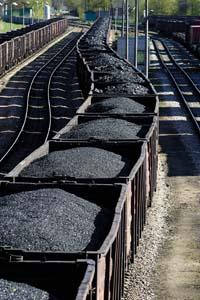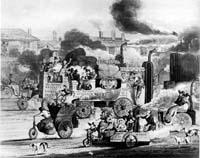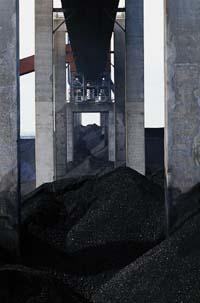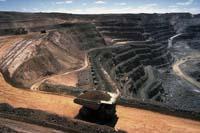Path from black to green

Although the first uses of coal are very earlier, the XVIII. and XIX. In the twentieth century it acquired a great importance. Coal was one of the most important revolutionaries of the industrial revolution. It was then used to obtain mechanical energy through steam machines, and in the XIX. At the beginning of the twentieth century, even for the extraction of gas to illuminate the cities. Then came the era of electricity and changed the use of coal to produce electricity.
Thomas Edison launched the first coal-fired power plant in Manhattan in 1882. Since then, coal has been used primarily to generate electricity. Today, coal is still of great importance. The 40% of global electricity is obtained through coal. And coal production continues to grow year after year, almost doubling in the last 25 years.
Coal is essential for the economic stability of several countries. Fuel that is driving economic growth from China and India. And the US. and the European Union, for example, have included coal in their strategic plans as a source of energy to consider in the future.
Abundant, cheap and black
According to data provided by the World Coal Institute, the known reserves amount to almost one billion tons of coal. This means there is coal for about 150 years. Oil and gas can be depleted in 40 and 60 years. On the other hand, coal reserves are quite distributed throughout the world. Coal is present in almost all countries, although the largest reserves are in the US, Russia and China. Comparing again with oil and gas, almost 70% of them are in the Middle East.

Taking into account these data, it is little wonder that several countries are interested in coal. In fact, it is the most abundant fossil fuel, it is cheap and, in addition, everyone has in his home.
But coal is black
Coal is basically carbon - depending on the type of coal can reach 70-98% carbon. Therefore, when burning coal, carbon binds to oxygen, releasing CO 2 more than any other fuel. And CO 2 is transparent, but we know which color has consequences…
To generate an hour of coal electricity, a kilo of CO 2 (in the United States, according to MIT) is issued. The generation of the same amount of electricity from natural gas means a maximum of half of it, while the use of wind, solar or nuclear energy does not imply the emission of CO 2. Thus, coal has much to do with the greenhouse effect, which every year emits 10,000 million tons of CO 2 to the atmosphere. The burning of coal is the human activity that more CO 2 emits after petroleum derivatives burned in transport.
After carbon, hydrogen is the most important component of coal. But it also has impurities. For example, it is common to have nitrogen and sulfur. As a result, when burning coal oxides of nitrogen and sulfur (NO x and OS x) are also emitted which can cause acid rain. Other impurities, such as heavy metals, are released as particulate matter and can produce smog.

Green technologies green technologies
However, in the last 25 years, a great effort is being made to develop clean coal technologies. And on that road the plans of the US and the EU go. The goal is to develop these technologies as quickly and quickly as possible to make coal more green.
Coal is broken and burned in a boiler in the thermal power plants used to date for the generation of electricity. The heat provided by this combustion converts water from the pipes surrounding the boiler into steam. This high-pressure steam moves the steam turbines. Finally, electric generators convert the mechanical energy of the turbines into electricity. At present, this is how 90% of the electricity generated from coal is obtained.
Clean coal technologies enable to largely control particles NO x, OS x and others that are released by burning coal in modern power plants. On the one hand, coal can be previously cleaned by various procedures, partially eliminating sulfur and mineral impurities. This allows to reduce ash in half. In addition, the treated coal in this way can increase the efficiency of the power plants, so it should be emitted less CO 2 than otherwise to obtain the same amount of electricity.
Exhaust gases can also be treated after combustion. Electrostatic filters and precipitators allow the collection of 99.5% of the particles. Other procedures allow reducing sulfur and nitrogen oxides by 99% and 80-90% respectively.
The reduction of CO 2 emissions is another issue. And that is precisely the greatest current challenge. One way to do this is to increase the efficiency of energy transformation. In this way, higher efficiency, higher electricity is obtained with the same amount of fuel and, in proportion, lower emission of CO 2.

The average efficiency of the power plants is 30%. But as technology advances, the efficiency of the power plants is increasing. In the so-called supercritical and ultra-critical power stations, steam is subjected to higher temperatures and pressures, allowing an efficiency of 40-50%.
There are integrated gasification combined cycle plants (IGCC). In the plans of beautification of coal, it is bet, above all, for this type of plants. In these plants, instead of directly burning coal, it is gasified first. For this purpose, coal is treated with oxygen and pressurized water vapor. The result of this reaction is a mixture of gases composed mainly of carbon monoxide and hydrogen: synthesis gas.
Subsequently, this synthesis gas is easily moved by a gas turbine. However, the resulting combustion gases still have enough heat to evaporate water. And that steam moves another turbine. Both turbines, therefore, work in combined cycle to produce electricity. In this way a high efficiency of 40-50% is achieved. In addition, the synthesis gas can be purified before being burned to reduce emissions of NO x and OS x by 95-99%.
However, the increase in efficiency allows to reduce CO 2 emissions by a maximum of 25-30%. But if you want to emphasize coal, it will be more necessary. CO 2 emissions must be reduced much more until they are eliminated if possible. To achieve this, researchers investigate carbon capture and storage technologies. The goal is to capture and store CO 2 from burning or gasifying coal in safe places to prevent it from reaching the atmosphere.
In fact, CO 2 capture technology is developed and used for the food and chemical industry to obtain pure CO 2. However, to be able to use it in large volume, a greater development of this technology is necessary.

It is possible to capture CO 2 of the exhaust gases of conventional power plants, therefore, but it should be worked with large volumes and besides being expensive, it would be necessary to have a lot of energy. Therefore, it is possible that it is not profitable in this type of power plants. In the IGCC plants, on the contrary, CO 2 can be recovered before the synthesis gas is burned. For this purpose it is necessary to make a conversion of carbon monoxide in the synthesis gas: with the help of the appropriate catalyst, the CO reacts with the water vapor giving CO 2 and H 2. In this case, CO 2 would be more concentrated and it would be easier to separate it from the synthesis gas. Eliminating CO 2 would be the hydrogen that would be used as fuel. It must be taken into account, therefore, that the IGCC power plants can also be a way of obtaining hydrogen from coal.
Once the CO 2 is caught, you have to keep it in a safe place. To do this, experts propose to compress and bury CO 2 in porous rocks or saline aquifers, for example. According to a 2005 Intergovernmental Group on Climate Change (IPCC) report, the likelihood that a well-selected geological deposit will retain more than 99% of CO 2 is very high for 100 years and high for 1,000 years.
Red scars
But if all this is achieved --get coal energy without emission of CO 2 or other pollutants -, this green coal would still be scarred. Coal production is a quite destructive industry. On the one hand, it is a dangerous activity for the human being that generates numerous health problems - according to official data, in 2005 6,000 people died in China for reasons related to coal mines (diseases, accidents...)-. And on the other hand, coal mines have a great impact on the environment: forests and mountains are left alone and red, water and air are contaminated, methane (greenhouse effect) is emitted...
It is possible that much can also be improved in the production of coal. But, can you really get green coal?

It is difficult and expensive to catch the CO 2 of today's power stations. For this purpose, a large part of the extracted energy should be used. In the IGCC plants, on the contrary, the central one is very expensive. However, in them, on the contrary, it would be more profitable to collect CO 2. In any case, the cheapest will be to continue issuing CO 2. And as long as the numbers are red, who will start to catch carbon?
To do this, it will be necessary to adopt measures that increase the cost of dumping of CO 2 with respect to capture. For this reason, experts propose to develop an adequate carbon regulation.
Green, red or black, it seems that the coal so important in the past is recovered again. Technology can help make coal consumption not so dirty. But you will have to see where the coal is on that road from black to green and the color it takes.






